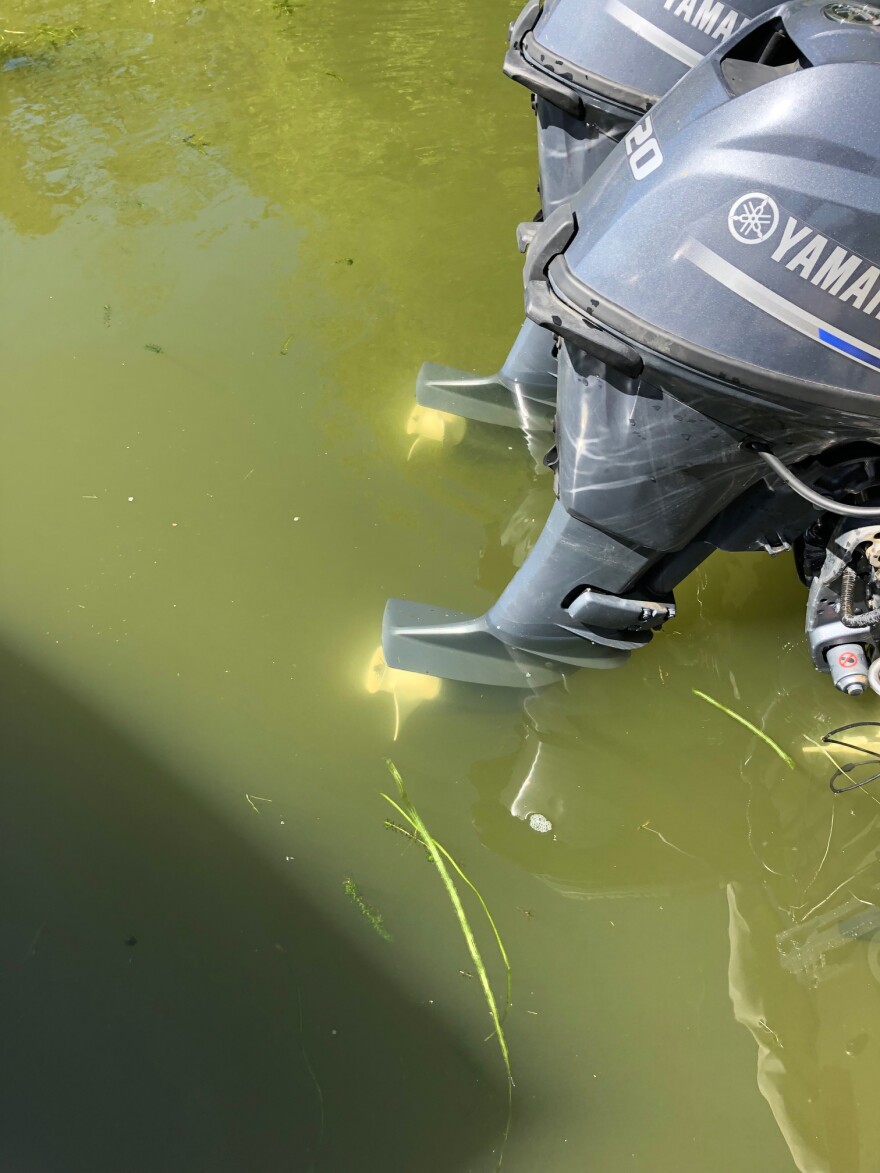This summer’s media coverage of several dogs that died shortly after swimming in water tainted by toxic algae has brought public attention to the phenomenon of algal blooms. Federal agencies consider them an emerging public health issue and a major environmental problem across the U.S.

The intensity and frequency of these blooms are expected to grow because of climate change, and that has federal, state and citizen scientists racing to understand when and why the blooms suddenly turn toxic.
On a sunny September day, the water lapping at the shore of Sabattus Pond just east of Lewiston isn’t blue — it’s green and murky. Jeremy Deeds, an aquatic ecologist with the Maine Department of Environmental Protection, says that indicates that this 1,900-acre body of water has an algal bloom.
“Sabattus Pond, it’s usually having some level of bloom of algae throughout the entire year,” he says.

Deeds says at times, the bloom is so bad it forms a thick scum and looks like green paint.
To learn more about this phenomenon, Deeds and other scientists come here every few weeks to gather clues. He motors out to the middle of Sabattus Pond with Charlie Culbertson, a microbial ecologist with the U.S. Geological Survey. They check the water’s clarity and take its temperature, and then Culbertson prepares a giant syringe about the size of a frozen popsicle to collect a sample of the water’s DNA.
As Culbertson pushes water through the syringe, the filter inside turns from white to green. What’s making it green — the source of the bloom — is cyanobacteria, sometimes called blue-green algae, which Culbertson says are among the oldest form of life on the planet.
“They’re fantastic organisms. They’re so well adapted to their environment,” he says.

And climate change, says Culbertson, is creating conditions for them to thrive.
“Warmer, wetter, higher CO2 in the atmosphere — plays right into their wheelhouse,” he says.
There’s another factor in Sabattus Pond that helps cyanobacteria grow: excess nutrients. Agricultural runoff going back decades has deposited phosphorous into the pond, setting the stage for the cyanobacteria population to explode. And Culbertson says those blooms can produce harmful cyanotoxins.
“Just because the organism is here does not mean it’s toxic, but it can shift on a dime,” he says.
That’s worrisome because it can cause serious health problems, for people and pets.
Several dogs in southern states died this summer shortly after swimming in water with toxic algal blooms. Here in New England, regional poison center Director Dr. Karen Simone says calls related to algal blooms have been coming in since 2004.
“We’ve had 44 calls involving humans who think they were been poisoned, and six involving animals, mostly dogs, who we think may have been poisoned,” she says.
Simone says just a few of those calls came from Maine, with the rest from New Hampshire and Vermont. She says humans poisoned from algal blooms typically experience nausea, diarrhea, skin rashes and, in more serious cases, liver or kidney damage. Pets — especially dogs -— are more likely to experience more severe neurologic problems.

“One of the cases that stands out to me involved a dog that was swimming, and for this particular dog, there was a weakness and almost paralysis of the back two legs,” she says.
Though Maine doesn’t see algal blooms with the same severity and frequency as in the south, scientists say that will likely change. Scott Williams with the group Lake Stewards of Maine says in recent years, several lakes have experienced severe and unexpected, algal blooms.
“And in each case, we’re fairly confident that climate change was part of the equation, part of the influence for those blooms,” he says.
Williams is standing on the shoreline of Lake Auburn, just a short walk from his office. It’s the only public water source for the cities of Lewiston and Auburn.
“And this is a lake that historically has very good water quality. It’s the drinking water supply for two large communities, Lewiston and Auburn. And in 2012, the lake experienced a very serious bloom,” he says.
That year, Williams says, warmer spring temperatures melted the ice early. Then a severe storm caused substantial erosion, dumping nutrients in the watershed. That created ripe conditions for an algal bloom that depleted the lake of oxygen and caused a fish kill.
The lake recovered, but another algal bloom last year caused taste and odor issues in the water supply, prompting the city to apply a special treatment.

Williams says there are ways to prevent algal blooms, such as limiting runoff and allowing native plants to grow on shorelines to act as filters. But he says change is already happening in Maine’s lakes, and the state must adapt.
“From our perspective, the most important thing is to get as many trained people out there and gather as much information as possible so we can better understand which lakes are most risk and see what can be done to reduce that risk,” he says.
Maine has about 3,000 lakes in the public domain, which makes it a challenge to monitor them all. Lake Stewards of Maine trains volunteers who monitor just under 500. They share that data with the state DEP, which regularly monitors about two dozen lakes for blooms.
Back on Sabattus Pond, Deeds says the water quality in most of Maine’s lakes is very good. But he says the need to better predict toxic algal blooms is urgent.
“The numbers are small right now, but we are seeing a trend toward lakes getting worse. And when they do get worse, they get worse in a hurry.”
This story is part of a week-long reporting project “Covering Climate Now,” by Maine Public and more than 300 other news outlets around the world. The series comes in advance of the United Nations Climate Action Summit on Monday Sept. 23 in New York. More information at MainePublic.org/climatenow.
Originally published 5:23 p.m. Sept. 17, 2019




